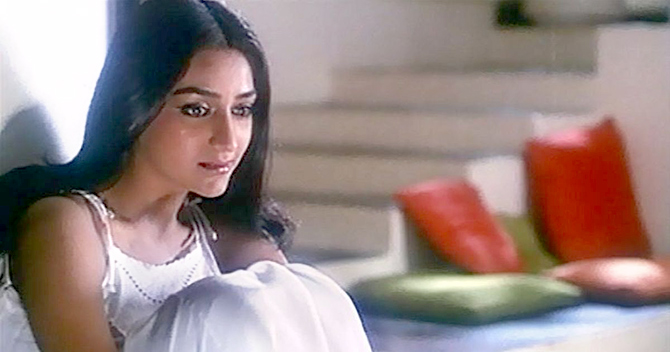Looking back on my brief life as a film critic, I can see clearly the key role that subtexts and their uncovering had played in my getting started on this path.
It was, over those many casual exchanges of ‘buried meanings’ that my perception about cinema, as a narrative art with secret pathways and hidden chambers, was born.
Back then, it didn’t strike us that this trading of useless gossip could also have been worth a second glance.
We were merely looking to shoot the breeze, while away the time.
This piece then is a tribute to that corner of film criticism that they call subtextual film criticism.
Friends, acquaintances, fellow cinephiles, film-makers, and my younger self have all contributed to the list below.
I hope we spot some of our grand follies and lost innocence, here.
The ‘Samaan‘ in Mera Kuch Samaan
Intellectually speaking, she was my worst enemy, but alas, she was also nothing less than the greatest churner of ideas and taste.
Five years my senior, and specialist par excellence in subjects as diverse as poetry, cooking and Konkani swear words, she could take me down when I was operating above my station, and could astound me with a piece of wicked knowledge I had no idea existed.
All of 21, having first heard the song just a day before, I told her how much I loved Gulzar’s Mera Kuch Samaan.
“You know what the Samaan in that song stands for, right?” she asked.
I remember coming up with some guesses of the Hallmark Card variety.
“No you duffer, by Samaan, she means her virginity.”
There was a long pause.
“Now try going over that song once again,” she said, as if laying out my task for the day.
The reversal of gender equations in Junglee
A drunken cinephile, who will mock hammy acting, cite examples of poorly done action sequences, and regurgitate for you the most pointless stanza of the most pointless Hindi film song (often accompanied by unconscious table tapping), is a relatively harmless, even sociable animal.
A drunken cinephile, who will badger you with a piece of academic observation is, however, a beast to be avoided at all costs.
“You see, Ehsaan Tera Hoga from Junglee is a great example of a cinematic moment that reverses gender equations,” a post-modernist/post-structuralist once told me, two pegs down.
I respond not warmly to such observations, and so he proceeded to expound his theory.
“If you look at that song carefully, it has Shammi Kapoor all clean shaven and Saira Banu sporting bits of moustache.”
“Here,” he continued, pulling out his mobile phone, and playing the video on Youtube.
And you know what — the man wasn’t being merry. Saira Banu’s and Shammi Kapoor’s upper lips are indeed crossed in a way that proved our post-modernist’s theory about the reversal of gender equations right.
I quietly poured myself another drink.
Gabbar Singh as someone who respects women
Being asked to explain the enduring appeal of a character he had created some 40 years ago must be tough on any writer. And so, I wouldn’t fault Javed Akhtar for gambling just a bit in his attempt make a de-sanitised character like Gabbar Singh relevant to these highly sanitised times.
Still, his one remark, at an event held to commemorate Sholay, turned out to be one hell of a gamble.
Here’s Javed Saab (and I am paraphrasing): ‘Gabbar, for all his malevolence, never really looked at women with lustful eyes. He never passed lewd comments about a single woman. Hence, his popularity.’
This was subtextual criticism taken to a whole new plane, and I wish I could remember now, the source of this weird analysis, the exact question that prompted this answer.
I can only guess that it could have been something of the order of: “Javedsaab, why do people love Gabbar Singh so much?”
Er… for the same reason that women love sex offenders?
Ee Ma Yau as a campaign against the sale of illicit liquor
The following incident occurred on a Whatsapp Group of Malayalam Cinema lovers.
Ee Ma Yau, Lijo Jose Pellissery’s follow-up to Angamaly Diaries, had been watched, and dissections were in full flow.
I messaged that it was a film about Death, and also a rant against God.
One group member didn’t agree with my bringing God into the discussion as he thought that Pellissery had intended for his film to be a rejection of organised religion.
A third member supported my hypothesis about Ee Ma Yau being a rant against God but more specifically, he said, it was a tale about the hypocrisies of the church.
A Catholic butted in, and corrected the last reading: “Not just any church, but the Latin Church.”
A wise man messaged, just in time: “Ee Ma Yau is a campaign against the sale of illicit liquor in Kerala. Everybody who dies in the movie, including a dog, dies of alcohol poisoning.”
The messaging stopped, cooled off by the recognition that we had travelled the entire spiritual spectrum — God, Church, Religion, Godlessness, and Bergman — only to arrive at something earthly: Illicit Liquor.
Feminists against Satyajit Ray
This present generation of feminist critics is far more reasonable than the one that came before it.
The previous generation of rabid feminists was out to re-value all great artistic works of the past.
Somebody from that generation once explained to me why Satyajit Ray’s treatment of Durga, in Pather Panchali, was close to sadistic.
“It was as if Ray wanted to punish Durga for not being like her petulant little brother, or like her responsible mother. There she was, Durga, stepping into adolescence, eager to respond more instinctively to the rhythms of nature, and Ray, instead of celebrating her spontaneous dance, kills her off almost right away.”
In short, she was disappointed that Ray had given us something heartbreakingly beautiful, instead of just a dancing Liril Girl.
Top Gun as a man’s struggle with his own homosexuality
Since Jackie Brown, I haven’t been able to sit through more than 15 straight minutes of a Tarantino character wallowing in his loquaciousness. However, listening to Quentin Tarantino talk about movies, and his interpretations of popular movies, was, and continues to be, a goddamn delight.
This cinema raconteur aspect of Tarantino is smartly tapped into by Director Rory Kelly in what was the only smart bit in his 1994 comedy, Sleep with Me.
Sleep with Me has Tarantino appearing as a guest at a party, and breaking into a long Tarantinoesque monologue about Top Gun and how it’s really the story of a man’s struggle with his own homosexuality.
‘Maverick (Tom Cruise’s character in Top Gun),’ Tarantino explains, ‘is right on the f****** line. And you’ve got Iceman (Val Kilmer), and all his crew. They’re gay; they represent the gay man. And they’re saying, go, go the gay way, go the gay way. He could go both ways.’
On and on he goes, and with such pastoral energy, that after a while you may be pushed into believing in his theory.
Perhaps they were a bunch of gay aviators after all.
Lesbians who escaped your attention
It’s no surprise that while gay subtexts in movies are picked out either in jest, or by a gay writer hoping to further his crusade, almost everyone loves to scrutinise a lesbian subtext. (This fact, I guess, ties in with a recent survey which states that close to 60 percent men and 75 percent women prefer watching lesbian porn).
Hindi movies with the most obvious lesbian subtexts (Dedh Ishqiya, Heroine and Angry Indian Goddesses) I wouldn’t waste your time talking about.
But did you know that Shaleen, the character played by Sugandha Garg in Jaane Tu… Ya Jaane Na, was supposed to be a lesbian?
Now, I want to believe the person who apprised me about this last factoid, but he soon announced himself as someone who found lesbian subtexts everywhere.
For example, he told me that Dola Re Dola from Devdas and Pinga from Bajirao Mastani are also filled with lesbian undertones.
“Are you sure?” I asked him.
“About 80 percent,” he said.
What Wing does he belong to?
2020’s alternative to guessing at artists’s sexual preferences is, guessing at their political affiliations.
You watch the small artistic choices that a film-maker or an actor makes, the statements uttered in passing, and try to sniff out where he or she stands on the political spectrum.
Reproduced below are a few exchanges from this category:
‘Neeraj Pandey is a soft right winger. He’s a Bhakt who just wouldn’t come out and say it.’
‘Anubhav Sinha is a transformed liberal, a bookish liberal if you may.’
‘Zoya Akhtar purports to be a left liberal, but she’s without any real knowledge of leftist politics. Maybe Anubhav Sinha could offer her some of his reading material.’
‘Sudhir Mishra… is a convenient liberal.’
‘Aamir Khan is a scared liberal; a liberal who knows that he runs the risk of eroding his fan base if he makes his liberalism any more apparent.’
***
‘We all know what Anurag Kashyap’s political affiliations are.’
‘Of course, he’s a Lefty.’
‘No no, more like Anti-Right. Actually, he’s Anti-whoever’s-in-power. If Ducks were in power, he’d be Anti-Ducks.’
***
‘How about Shekhar Kapur?’
‘Oh, he used to be a Lefty, but he’s totally swung the other way now.’
‘Really?’
‘Oh yes, Shekhar Kapur and Anubhav Sinha have basically traded seats.’
‘Zounds, that’s bad for politics and bad for the arts.’
Discovering the macabre in Tom & Jerry
It was the summer of self-doubt; the summer when I realised that a certain cousin (ostensibly, the same age as I was) had outgrown me.
I used to spend most of my school vacations in his old-style home in Kerala, and this particular year, polemics were very much in order.
It all began with a lecture on how the demolition of the Babri Masjid was ‘a necessary act.’
I was a relatively apolitical Bombaywallah (as kids in Mumbai still tend to be) who thought that nothing with the word ‘demolition’ in it could possibly have good consequences.
Backed up by historical and political data, he demonstrated how naive I was; that I was a Hindu waiting to be trampled by the ‘secular world’ of my Civics textbook.
“You don’t think, do you?” said he, his frame too small for the armchair he was trying to fill.
Later that night however, things turned bloodier.
We were watching a three-hour movie version of Tom & Jerry on VHS tape, and he caught me at the high point of a quaking laughter.
“It’s funny!” I said, as if defending myself.
“It’s not what you believe it is,” he said.
“What do you mean?” I said.
“Jerry,” said the cousin, “He isn’t actually alive. The whole of Tom & Jerry is Jerry’s one long dying dream. He has already been killed by Tom, and in his dying moments, he’s fantasising about all those things he couldn’t do when he was alive.”
I looked at my fast-maturing cousin with awe.
“You don’t think, do you?” said he, this time, lying proudly on his swing bed.
A Death in the Gunj as a study of colonial hangovers
I watched Konkona Sensharma’s debut film with a bunch of South Bombay-ites who gasped and blew their noses every time the film’s protagonist, Shutu — ritualistically referred to as ‘poor Shutu’ — was mistreated by his relatives.
I, for the life of me, cannot respect a work of art if it so easily confers saintliness and enlightenment upon its audience.
So unsaintly was my own response to A Death in the Gunj that I found a sex scene in the film to be its greatest achievement. (This judgment, I retain to date).
But otherwise, I thought A Death in the Gunj was a pretty interesting study of colonial hangovers: A chamber drama set in an Anglo-Indian community, with characters mimicking the worst elitisms of the British.
I emptied all of my personal readings into my review, and waited for the congratulatory calls and messages to arrive.
There was only one response, and it was a Twitter putdown which said: ‘Wish I could review this review. Clearly, I watched a completely different film.’
That putdown fetched two likes, one of them from Konkona Sensharma.




